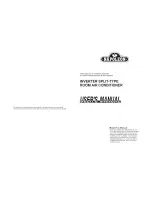
3
3
- 95
Control of Mini ECO-i SYSTEM
7. Remote Sensor
I
How to Install the Remote Sensor
< NOTE 1 >
Do not twist the remote sensor wiring with the power wiring or run
it in the same metal conduit, because this may cause malfunction.
< NOTE 2 >
Install the remote sensor away from sources of electrical noise.
< NOTE 3 >
Install a noise filter or take other appropriate action if electrical
noise affects the power supply circuit of the unit.
•
Use an electric junction box (supplied locally) (Fig. 3-57) for flush mounting of
the remote sensor.
Fig. 3-57
Simplified remote controller
Under case (back case)
Spacer
Machine screws
M4
×
25 (2)
Electric junction box
for one box (no cover)
Wall
1. Insert a screwdriver or the like in the groove on the lower side of the remote
sensor body to pry off the back case. (Fig. 3-58)
2. Use the 2 supplied M4 machine screws to secure the remote sensor back case.
Prior to mounting, clear the cutouts in the back case corresponding to the
holes in the wall box using a screwdriver or the like. Use the spacers and take
care not to tighten the screws excessively. If the back case will not seat well,
cut the spacers to a suitable thickness.
3. Connect locally supplied 2 core lead wires to the lead wires from the remote
sensor. (See “How to wire the remote sensor.”)
When connecting the locally supplied 2 core lead wires to the terminal
block, check the terminal numbers in the indoor unit to make sure that
the wires are correctly connected. (Fig. 3-59)
(The remote sensor is damaged if 220 / 240V AC is applied.)
4. Fit the remote sensor to the tabs of the back case and mount it.
Fig. 3-58
Unit: mm
06-405 Mini-ECOi_TD3 11/6/06 6:18 PM Page 95
Summary of Contents for SPW-CR365GX56
Page 5: ...1 1 1 Outline of Mini ECO i SYSTEM Contents 1 OUTLINE OF MINI ECO i SYSTEM 1 Line up 1 2 ...
Page 8: ...1 4 MEMO ...
Page 322: ...4 180 MEMO ...
Page 344: ...5 22 MEMO ...
Page 345: ...200611M DC ...
















































